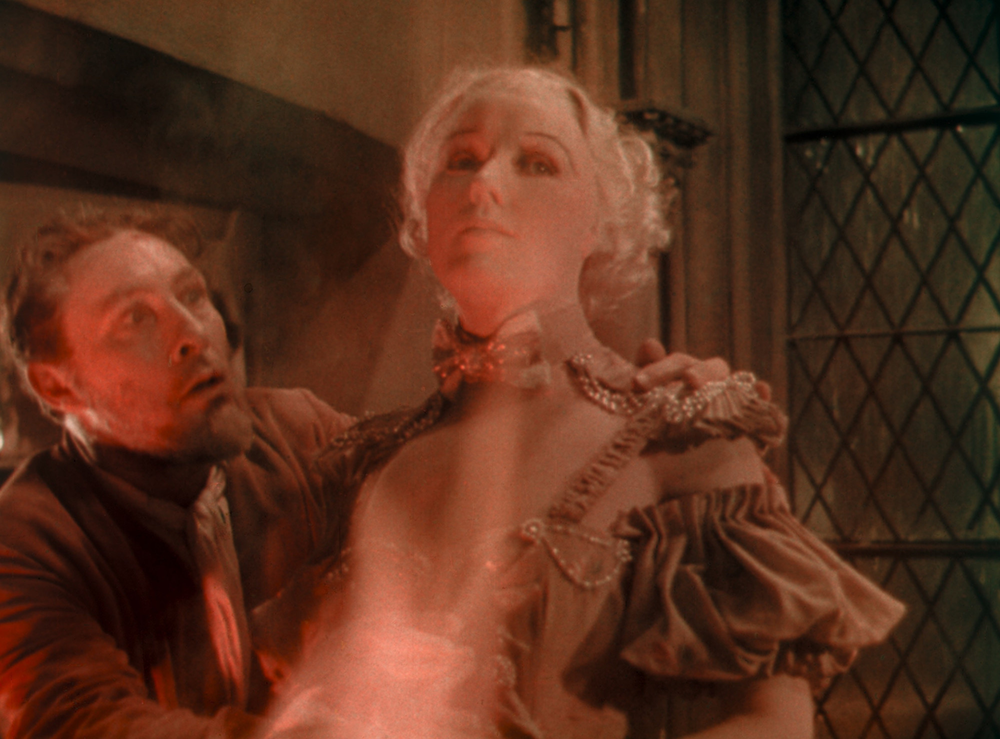Two months before the release of “King Kong” (1933) would make ‘The Scream Queen’ Fay Wray a star, audiences witnessed a preview of her considerable pipes in Michael Curtiz’s “Mystery of the Wax Museum,” a ghoulish two-strip technicolor treat. For a crowded 78 minutes, the characters (the wax figurines and their human counterparts) shine in a pre-Code horror bash. The film itself embraces some lurid taboos: drug addiction, grisly deaths, and suggestive sex talk. An inspired yet original pastiche of horror, noir and comedy, “Mystery” was Warner Bros.’ answer to the Universal Studios’ monsters (Frankenstein, Dracula, Et al.) that captivated and frightened viewers in the early 1930s. Lost for decades until an original print was found in Jack Warner’s private collection, “Mystery” is a crisp and busy film, well-crafted entertainment that’s still screaming after all these [ninety] years.
While Wray would soon become a household name, it was Lionel Atwill earning top billing as Ivan Igor. He is the humiliated wax sculptor who attempts a comeback under macabre pretenses. The film wastes no time setting up Igor’s dilemma: two museum representatives tour his facility and promise to feature his work (especially Igor’s prized possession: a wax sculpture of Marie Antoinette). However, Igor’s business partner shows up and burns the place to the ground to collect insurance money. The fire destroys all of Igor’s work and leaves him badly burned and injured. And though he’s unable to work or walk (or so it appears), Igor is determined to exact revenge and reclaim his past passion, no matter whose life it costs.
A Horror Film that Does So Much with So Little
The fun is not just how Igor rebuilds his life, but who becomes part of it. Atwill is menacing in a theatrical and campy performance that evokes a bizarre blend of Vincent Price and Laurence Olivier. (No surprise then that Price would assume Atwill’s role in the 1953 remake, “House of Wax.”) Still, the formality of his affect would make it difficult to follow him and only him even during such a short run-time. Enter Glenda Farrell as Florence, the down-on-her-luck newspaper gal who livens up the film. She will eventually blow the whistle on Igor, saving her roommate Charlotte (Wray)—who Igor believes is a spitting image of his beloved Marie Antoinette—and, in the film’s pat finale, finding love.
At first, Florence seems out of place in a standard horror movie. But, it’s her presence that helps lift the film out of a predictable arc. It infuses some humor and mystery to counter the energy of the demented, tortured Igor. Curtiz perhaps recognized that his team couldn’t beat Universal at its own game. However, by rewriting the rules, the creative team developed a devilish delight with something for all tastes. Florence’s zip and sass must have resonated with audiences. Her role here led to Farrell’s casting as reporter Torchy Blane in “Smart Blonde” (1937), followed up with an additional six Blane films in which Farrell reworks and revisits her Florence in “Mystery.” Her fall (to unemployment), then rise (to hero) contrasts with Igor’s. He starts the film in love with his sculptures and ends up meeting the same fate as those models.
Fay Wray is Fun; Atwill and Farrell Steal the Show

Despite the film’s age, it looks astonishing, like sandpaper on the more refined Technicolor process, which would soon dominate the color film industry. (This was the last studio feature to appear in two-color technicolor.) The wax sculptures look alive even when they’re on fire. Additionally, the foggy tint of the backgrounds lends an ominous tone to the characters’ fates. In this film, the whole crew deserves shoutouts, especially art director Anton Grot (who would be nominated four five Oscars in his career), cinematographer Ray Rennahan (who won two Oscars, including for “Gone With the Wind”) and Curtiz. A consummate workhorse, Curtiz had 178 directing credits over a fifty-year career, which started in 1912 in his native Hungary. Known now mostly as the guy who directed “Casablanca,” Curtiz was new to the horror game then. Perhaps that itself informs the fresh approach to the genre.
Wonderful as it is to see a familiar face such as Fay Wray, the film belongs to its character actors: Atwill and Farrell, performers as prolific in front of the camera as Curtiz was behind it. The performers are matched to their roles precisely, so their behavior never feels contrived. And nor does the tone: it’s funny when it wants to be, scary when it doesn’t try to be. And it’s shocking for the fact it was able to do so much with so little, so long ago. When Igor plunges into the vat of steaming wax, I thought of “Batman” (1989), and wondered if “Mystery” influenced that splashy, ominous scene which made the Joker. Regardless, that possible connection proves the case that the film is an enduring and accessible Halloween horror throwback, a film which fits the cliche that they don’t make ‘em like they used to.
You can currently watch “Mystery of the Wax Museum” on HBO Max or Retro Reels.
Support the Site: Consider becoming a sponsor to unlock exclusive, member-only content and help support The Movie Buff!